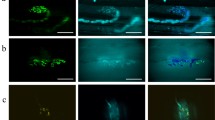Abstract
After experimental application of colchicine to the motor nerve of a muscle to disturb fast axoplasmic transport the area of cross section of the muscle fibers was reduced, the number of fibers with low succinate dehydrogenase (SD) activity was increased, and the muscle fibers were more homogeneous as regards their optical density after staining for SD activity. Similar changes also were found after division of the motor nerve. However, denervation was accompanied by blocking of conduction and degenerative disturbances in the nerve endings. In preparations treated with colchicine the conduction of excitation in the nerve and through the synapse continued and miniature end-plate potentials (MEPP), end-plate potentials (EPP), and action potentials (AP) of the muscle fibers were recorded. It is concluded that fast axoplasmic transport supplies the muscle with substances maintaining the differentiated state of its fibers.
Similar content being viewed by others
Literature Cited
B. L. Van der Waerden, mathematical Statistics [Russian translation], Moscow (1960).
N. A. Plokhinskii, Biometrics [in Russian], Moscow (1970).
C. E. Aguilar, M. A. Bisby, and J. Diamond, J. Physiol. (London),226, 60P (1972).
E. X. Albuquerque, J. E. Warnick, J. R. Tasse, et al., J. Exp. Neurol.,37, 607 (1972).
G. S. L. Appeltauer and I. M. Korr, J. Exp. Neurol.,46, 1 (1975).
R. Birks, B. Katz, and R. Miledi, J. Physiol. (London),150 145 (1968).
G. G. Borisy and E. W. Taylor, J. Cell. Biol.,34, 525 (1967).
A. Dahlstrom, J. Haggendal, and A. Linder, Eur. J. Pharmacol.,71, 41 (1973).
P. F. Davison, Adv. Biochem. Psychopharmacol.,2, 289 (1970).
W. K. Engel and R. L. Irwin, Am. J. Physiol.,213, 511 (1967).
W. W. Hofmann and S. Thesleff, Eur. J. Pharmacol.,20, 256 (1972).
N. L. Katz, Eur. J. Pharmacol.,19, 88 (1972).
R. Miledi and C. R. Slater, Proc. Roy. Soc. B.,169, 289 (1968).
S. Ochs, Science,176, 252 (1972).
J. B. Olmsted and G. G. Borisy, Microtubules, Madison, Wis. (1973).
Rights and permissions
About this article
Cite this article
Volkov, E.M. Morphological and histological characteristics of frog skeletal muscle on application of colchicine to the motor nerve. Bull Exp Biol Med 83, 413–415 (1977). https://doi.org/10.1007/BF00799380
Received:
Issue Date:
DOI: https://doi.org/10.1007/BF00799380



